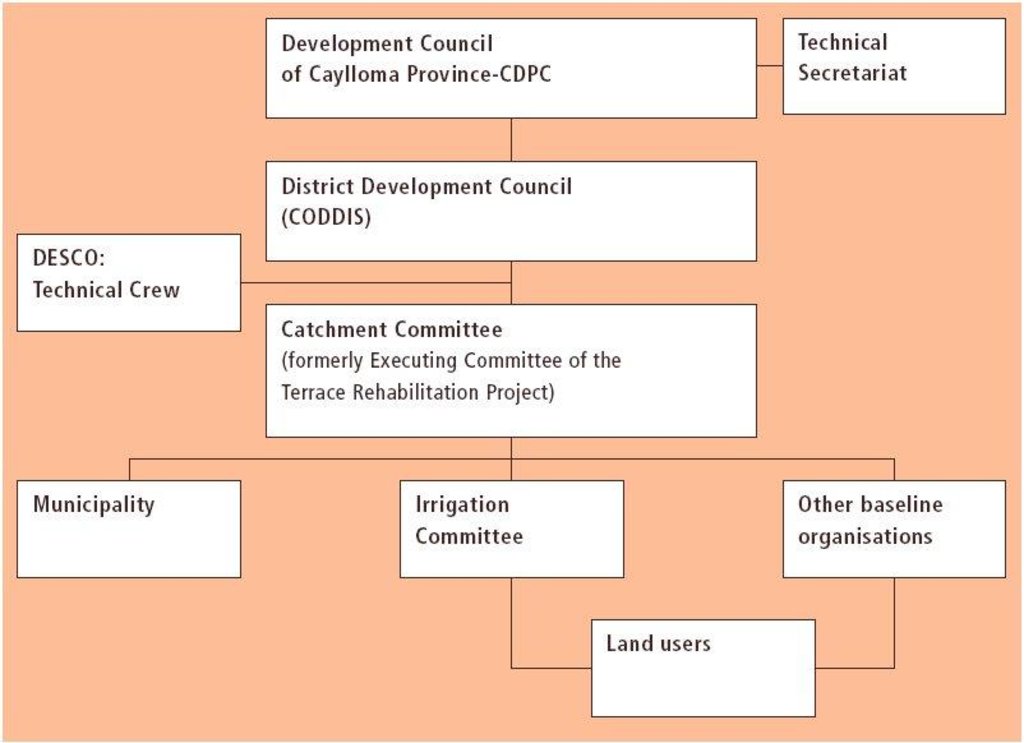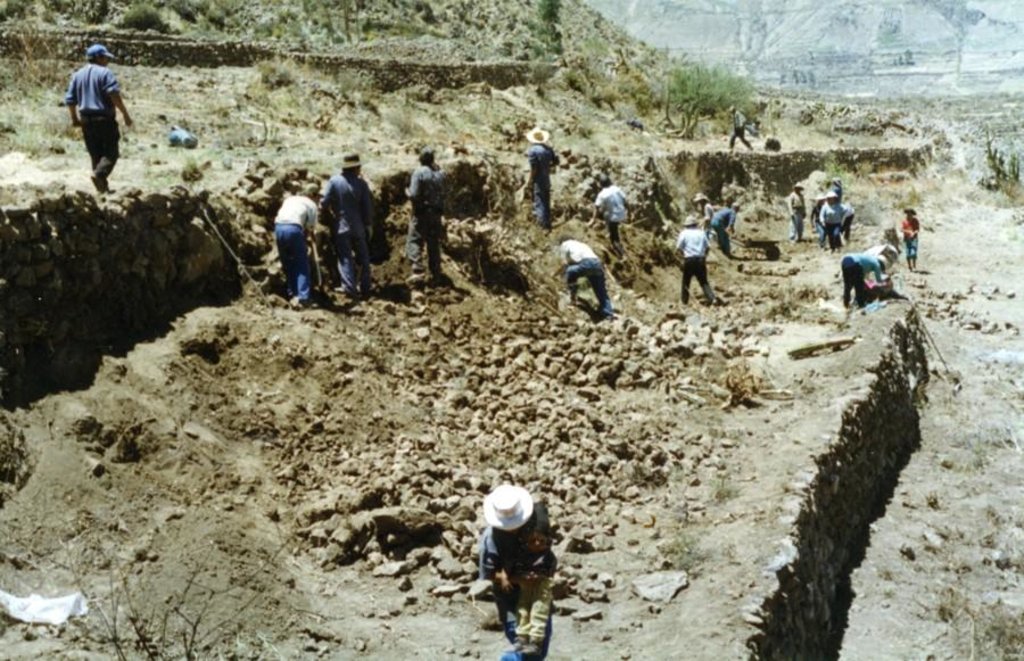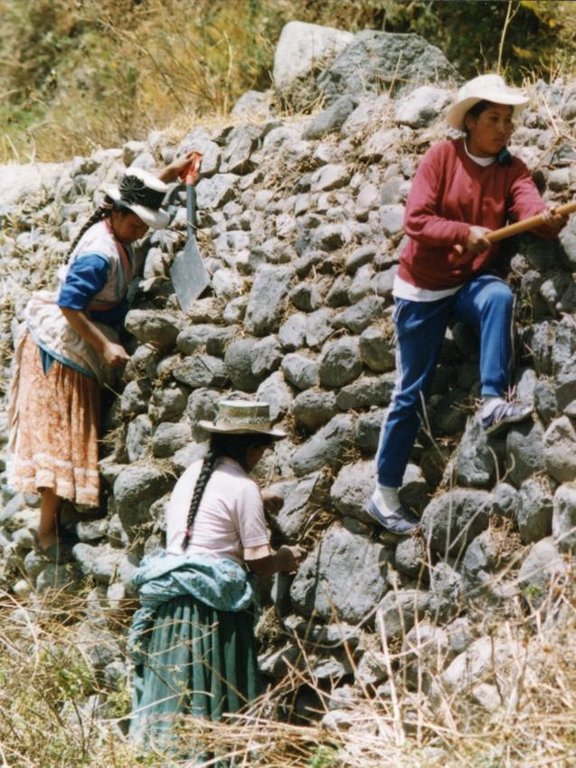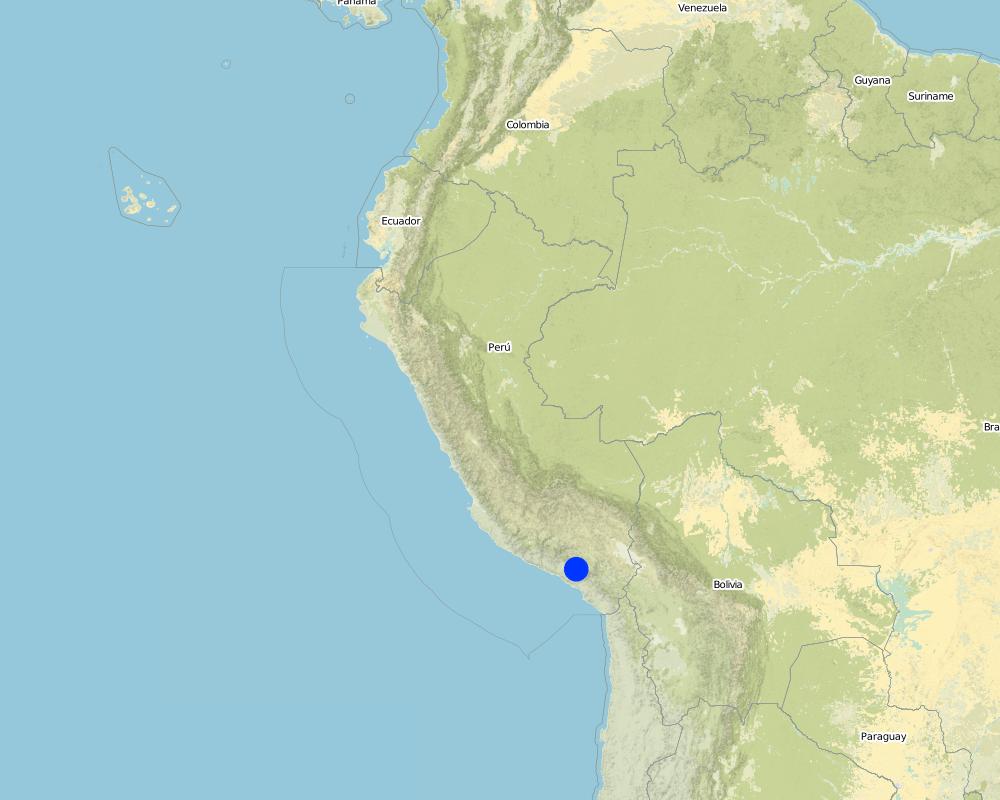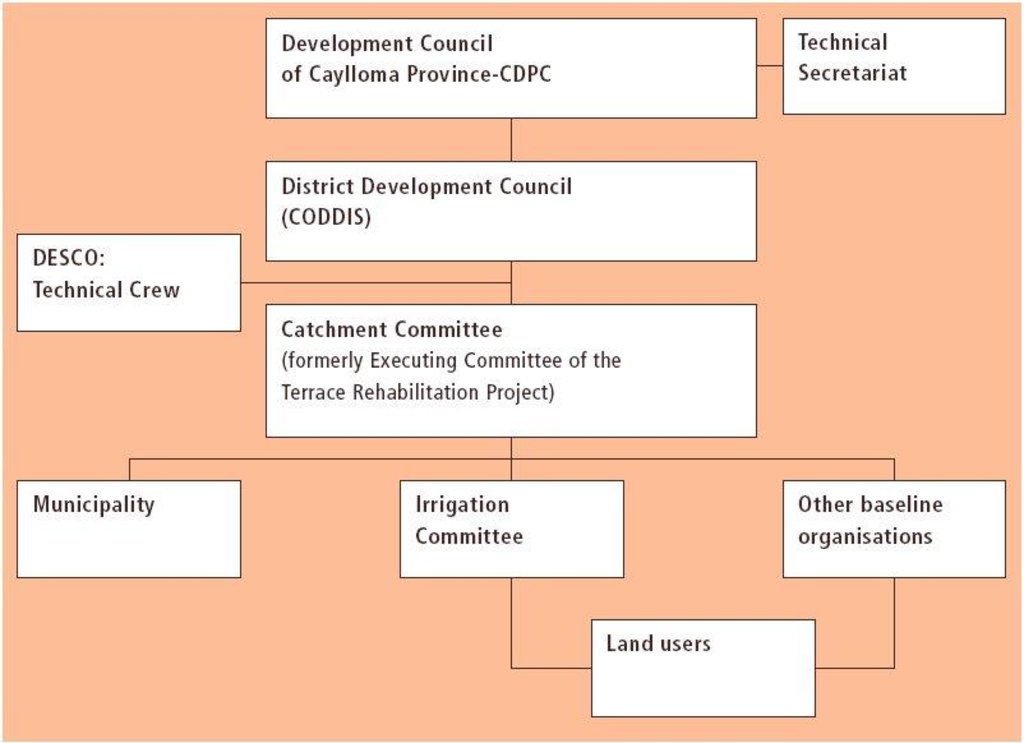Participatory catchment rehabilitation (Participación comunitaria para la rehabilitación de cuencas) [Perú]
- Creación:
- Actualización:
- Compilador: Philippe Zahner
- Editor: –
- Revisor: Fabian Ottiger
approaches_2347 - Perú
Visualizar secciones
Expandir todo Colapsar todos1. Información general
1.2 Detalles de contacto de las personas de referencia e instituciones involucradas en la evaluación y la documentación del Enfoque
Especialista MST:
Marquina Rodolfo
descolca@terra.com.pe
Centro de Estudios y Promocion del Desarrollo - DESCO
Calle Malaga Grenet No. 678 Umacollo, Arequipa
Perú
Especialista MST:
Marcacuzco Aquilino P Mejia
Centro de Estudios y Promocion del Desarrollo - DESCO
Calle Malaga Grenet No. 678 Umacollo, Arequipa
Perú
Nombre de la(s) institución(es) que facilitaron la documentación/ evaluación del Enfoque si fuera relevante)
Swiss Agency for Development and Cooperation (DEZA / COSUDE / DDC / SDC) - SuizaNombre de la(s) institución(es) que facilitaron la documentación/ evaluación del Enfoque si fuera relevante)
Centro de Estudios y Promoción del Desarrollo (DESCO) - Perú1.3 Condiciones referidas al uso de datos documentados mediante WOCAT
El compilador y la/s persona(s) de referencia claves aceptan las condiciones acerca del uso de los datos documentados mediante WOCAT :
Sí
1.4 Referencia/s al/los Cuestionario(s) de Tecnologías MST
2. Descripción del Enfoque MST
2.1 Breve descripción del Enfoque
Promoting the rehabilitation of ancient terrace systems based on a systematic watershed management approach.
2.2 Descripción detallada del Enfoque MST
Descripción detallada del Enfoque MST:
Aims / objectives: The Center for Studies and Promotion of Development - DESCO, a Peruvian NGO, started the Terrace Rehabilitation Project in 1993 to re-establish ancient terracing and irrigation practices that had largely been lost. The project is part of a general integrated development programme. Its overall purpose is to restore the productive capacity of terraced cropland, and to generate better living standards in the Colca valley. The project has the following specific objectives: (1) to increase the productive infrastructure through soil conservation and better use and management of existing water resources; (2) to increase levels of production; (3) to stimulate people in soil conservation and land management; and (4) to encourage/promote relevant local institutions. For implementation, a systematic watershed management approach was introduced. The catchment was considered the basic unit for development planning. Physical and socio-economic baseline studies were carried out. A strong community-based organisation, the catchment committee, was then founded. This consisted of representatives of major local grassroots organisations (irrigation committee, farmers' community, mothers' club etc). Responsibilities, commitments and rules were defined. Committee meetings and land user assemblies were the entities for planning, organisation and execution of project activities. DESCO initiated a process of 'concerted planning' in collaboration with other private and public institutions in Caylloma province.
Methods: In summary the project stages comprised: (1) project planning; (2) baseline studies; (3) catchment management plan; (4) constitution of the executive committee; (5) concerted planning of district development; and (6) organisation, execution, technical assistance and follow-up activities. Land users were required to participate in training courses and in fieldwork, to provide local materials and their own tools, and to fulfil duties within the organisations. Leaders and directors of grassroots organisations were responsible for planning and organisation of activities - implementation, training and follow-up - and for control and administration of project materials and inputs. The directors were also elected as representatives in the District Development Councils to participate in the evaluation and monitoring activities of the project.
2.3 Fotos del Enfoque
2.5 País/ región/ lugares donde el Enfoque fue aplicado
País:
Perú
Región/ Estado/ Provincia:
Rio Colca
Especifique más el lugar :
Arequipa, Peru
Map
×2.6 Fechas de inicio y conclusión del Enfoque
Indique año del inicio:
1993
2.7 Tipo de Enfoque
- proyecto/ basado en un programa
2.8 Propósitos/ objetivos principales del Enfoque
- to achieve higher levels of agricultural production and productivity through integrated development/management of soil and water resources. - to build capacity for planning, organisation and implementation of development activities
The SLM Approach addressed the following problems: - lack of employment opportunities/depopulation of rural areas. - lack of planning and action in 'concerted development' - little value associated with terrace rehabilitation. - low and unequal participation of women in field work. - general impoverishment of land users
2.9 Condiciones que facilitan o impiden la implementación de la/s Tecnología/s aplicadas bajo el Enfoque
normas y valores sociales/ culturales/ religiosos
- impiden
Women were treated unequally in terms of opportunities and salaries
Treatment through the SLM Approach: Equal treatment in salaries and better opportunities were ensured for women.
disponibilidad/ acceso a recursos y servicios financieros
- impiden
The poorest land users lacked the money to invest in terrace rehabilitation.
Treatment through the SLM Approach: Manual labour and tools were subsidised.
entorno institucional
- impiden
Coordination of planning and activities was lacking between different institutions and projects.
Treatment through the SLM Approach: District Development Councils (CODDIS) were strengthened as entities for coordination and concerted action.
marco de trabajo legal (tenencia de tierra, derechos de uso de tierra y agua)
- impiden
There was a lack of legal (registered) institutions to coordinate planning and strategies for sustainable land use at community level.
Treatment through the SLM Approach: An active effort was made to promote legalisation of, and give support to, grassroots organisations (eg Union of Land Users).
conocimiento de MST, acceso a apoyo técnico
- impiden
Local specialists in terrace rehabilitation and for construction supervision were lacking.
Treatment through the SLM Approach: Training and competitions were organised to develop skills and select the best.
otros
- impiden
Economical: Investment in cash crops was a problem for poor smallholders.
Treatment through the SLM Approach: Training/technical assistance was given for more profitable crops e.g potatoes, beans and peas.
3. Participación y roles de las partes interesadas involucradas
3.1 Partes interesadas involucradas en el Enfoque y sus roles
- usuarios locales de tierras/ comunidades locales
There were no differences in terms of salaries, but there were in terms of job opportunities: in a working group of 20 persons, typically only 5 women were contracted as terrace rehabilitation is very heavy work.
- especialistas MST/consejeros agrícolas
- profesores/ niños en edad escolar/ estudiantes
- gobierno nacional (planificadores, autoridades)
3.2 Involucramiento de los usuarios locales de tierras/ comunidades locales en las distintas fases del Enfoque
| Involucramiento de los usuarios locales de tierras/ comunidades locales | Especifique quién se involucró y describa las actividades | |
|---|---|---|
| iniciación/ motivación | interactivo | interviews/questionnaires, workshops/seminars, public meetings |
| planificación | auto-movilización | workshops/seminars; assemblies for decision making, workshops for local concerted planning |
| implementación | interactivo | casual labour, responsibility for minor steps; casual labour, responsibility for minor steps (land users in general); responsibility for major steps (leaders) |
| monitoreo y evaluación | interactivo | workshop/seminars, reporting, measurements/observations, interviews/questionnaires, public meetings; workshops, measurements/observations (directors of baseline organisations/leaders), reports (directors), interviews (directors/teachers), public meetings (land users) |
| Research | ninguno | none |
3.3 Flujograma (si estuviera disponible)
Descripción:
District Development Council (CODDIS): social organisations, public and private institutions jointly prepare economic and social development plans in a participatory manner, and under the leadership o
3.4 La toma de decisiones en la selección de Tecnología(s) MST
Especifique quién decidió la selección de las Tecnología/ Tecnologías a implementarse:
- principalmente por especialistas MST en consulta con usuarios de tierras
Explique:
the terraces were in an advanced stage of collapse and the local population did not have the means to reverse the process due to lack of economic resources.
Decisions on the method of implementing the SLM Technology were made by mainly by land users supported by SLM specialists. the technology is indigenous and adapted to the area. Evaluation workshops of, and activities permitting discussions on, the technology were carried out.
4. Apoyo técnico, fortalecimiento institucional y gestión del conocimiento
4.1 Construcción de capacidades / capacitación
¿Se proporcionó la capacitación a usuarios de tierras/ otras partes interesadas?
Sí
Forma de capacitación:
- reuniones públicas
Forma de capacitación:
- exchange of experiences
Temas avanzados:
A training plan at three levels was drawn up, addressing the following target groups and topics: (1) Selected land users, leaders, supervisors: in-depth training on the interrelations between water, soil and plants; terrace and canal construction; institution/enterprise management; natural resource management, conservation practices, and crop production. (2) Directors of grassroots organisations
4.2 Servicio de asesoría
¿Los usuarios de tierras tienen acceso a un servicio de asesoría?
Sí
Describa/ comentarios:
Key elements: technical assistance and sustained follow-up, supervision by specialised engineers, evaluation (reflection) and systematisation of gained know-how and developed practices with different stakeholders, function; testing of rehabilitated structures; Capacity for extension continuation has been built up within the catchment committee. However PRONAMACHS, a governmental SWC programme, is limited
4.3 Fortalecimiento institucional (desarrollo institucional)
¿Se establecieron o fortalecieron instituciones mediante el Enfoque?
- sí, mucho
Especifique el nivel o los niveles en los que se fortalecieron o establecieron las instituciones:
- local
Especifique el tipo de apoyo:
- financiero
- construcción de capacidades/ entrenamiento
4.4 Monitoreo y evaluación
¿El monitoreo y la evaluación forman parte del Enfoque?
Sí
Comentarios:
technical aspects were regular monitored by 0 through measurements; indicators: improved structures, results of technology tests
socio-cultural aspects were ad hoc monitored by 0 through observations; indicators: land users changing attitudes of SWC
economic / production aspects were ad hoc monitored by 0 through measurements; indicators: crop production increase
area treated aspects were regular monitored by 0 through measurements; indicators: rehabilitated area
no. of land users involved aspects were regular monitored by 0 through measurements; indicators: number of households that benefited directly
management of Approach aspects were ad hoc monitored by 0 through observations; indicators: number of catchments rehabilitated with terraces and agroforestry
There were several changes in the Approach as a result of monitoring and evaluation: There were various changes/readjustments of the approach: eg the concerted planning through the Local Development Councils was incorporated 5 years after the initiation of the project.
4.5 Investigación
¿La investigación formó parte del Enfoque?
Sí
Especifique los temas:
- economía/ marketing
- tecnología
Proporcione detalles adicionales e indique quién hizo la investigación:
Technology: research has been ongoing regarding functioning of the terrace and irrigation systems. Economy/commercialisation: research regarding agronomic production, catchment appraisals and market studies have been carried out for the main products of the area.
5. Financiamiento y apoyo material externo
5.1 Presupuesto anual para el componente MST del Enfoque
Comentarios (ej. fuentes principales de financiamiento/ donantes principales):
Approach costs were met by the following donors: international non-government (International NGO): 60.0%; government (national): 20.0%; local community / land user(s) (-): 20.0%
5.2 Apoyo financiero/material proporcionado a los usuarios de tierras
¿Los usuarios de tierras recibieron financiamiento/ apoyo material para implementar la Tecnología/ Tecnologías? :
Sí
5.3 Subsidios para insumos específicos (incluyendo mano de obra)
- equipo
| Especifique qué insumos se subsidiaron | En qué grado | Especifique los subsidios |
|---|---|---|
| maquinaria | parcialmente financiado | A-frames, tape measures, motor drills, wheelbarrows, shovels, picks, steel bars, sledgehammers,hoes, and compressors |
| herramientas | parcialmente financiado | |
- agrícola
| Especifique qué insumos se subsidiaron | En qué grado | Especifique los subsidios |
|---|---|---|
| semillas | totalmente financiado | Seedlings of tree species for establishment of the agroforestry component on terraces were produced in a project-owned nursery, and they were given free of charge to interested farmers |
Si la mano de obra de usuarios de tierras fue un insumo sustancial, ¿fue:
- pagado en efectivo?
Comentarios:
60% of the labour costs were met by the project.
5.4 Crédito
¿Se proporcionó crédito bajo el Enfoque para actividades MST?
Sí
Especifique las condiciones (tasa de interés el apoyo, amortización, etc.):
repayment conditions: Credit was provided by FONDESURCO to land users who participated in the rehabilitation project (for seed supply) with a lower interest rate than on the market. FONDESURCO is an NGO (of which DESCO is a member) specialised in microfinances in the rural sector..
5.5 Otros incentivos o instrumentos
¿Se usaron otros incentivos o instrumentos para promover la implementación de Tecnologías MST?
Sí
Si fuera el caso, especifique :
Support was provided to existing institutions (in the form of training, organisation and financial inputs). But with the formation of a catchment committee, an important grassroots organisation was built up.
6. Análisis de impacto y comentarios de conclusión
6.1 Impactos del Enfoque
¿El Enfoque ayudó a los usuarios de tierras a implementar y mantener Tecnologías MST?
- No
- Sí, un poco
- Sí, moderadamente
- Sí, mucho
There have been great improvements: introduction of high-value crops; 100% of the area cultivable; reduction of irrigation frequency by 20% due to higher efficiency of water storage by the terraces; various other SWC benefits.
Did other land users / projects adopt the Approach?
- No
- Sí, un poco
- Sí, moderadamente
- Sí, mucho
A few other projects have adopted the approach: eg the project of the Banco de Vivienda PRATVIR in the Coporaque area; also 'Popular Cooperation' in Ichupampa (covering just 2 ha).
6.3 Sostenibilidad de las actividades del Enfoque
¿Pueden los usuarios de tierras sostener lo que se implementó mediante el Enfoque (sin apoyo externo)?
- sí
Si respondió que sí, describa cómo:
Land users can continue the activities without external support, using traditional systems of mutual help and new forms of local organisation (catchment committee). With increased income through integration of cash crops the maintenance of the structures can be sustained.
6.4 Fortalezas/ ventajas del Enfoque
| Fuerzas/ ventajas/ oportunidades desde la perspectiva del compilador o de otra persona de referencia clave |
|---|
| Complementary conservation practices have been integrated into the terraces system: agroforestry, improved fallow, etc (How to sustain/ enhance this strength: Training of land users in the advantages and disadvantages of these practices.) |
| nstitutional capacity building: strengthening of organisations; increased participation (How to sustain/ enhance this strength: Continue the training of leaders.) |
| SWC training and extension activities. (How to sustain/ enhance this strength: Create spaces and mechanisms for daily practice of important cultural rituals/customs.) |
| 80% of land users have changed attitudes towards SWC, and are convinced of the benefits of terrace rehabilitation (How to sustain/ enhance this strength: SWC training and extension activities.) |
| Human capacity building: 60 specialists trained in rehabilitation technology (How to sustain/ enhance this strength: Create opportunities to ensure continuation of their work.) |
| An effective systematic watershed management approach applied at catchment level (How to sustain/ enhance this strength: Other projects/institutions should apply this approach.) |
| Soil conservation activities integrated in the plans of 'concerted development' (How to sustain/ enhance this strength: Strengthening of the Local Development Councils (CODDIS).) |
6.5 Debilidades/ desventajas del Enfoque y formas de sobreponerse a ellos
| Debilidades/ desventajas/ riesgos desde la perspectiva del compilador o de otra persona de referencia clave | ¿Cómo sobreponerse a ellas? |
|---|---|
| Labour overload in the family | Better planning of work at the household level. |
| The approach requires the participation of all social and political stakeholders - which is practically impossible | Strengthen the Local Development Councils (CODDIS). |
| The generation of income encourages the purchase of industrialised products | More training regarding consumption of local products. |
| The economic incentives provided by the project affected the existing reciprocal relationships (eg labour exchange) | Cash for work incentives are sometimes useful to overcome labour constraints due to depopulation. |
| Small holdings and land fragmentation are constraints for cost-effective agriculture | Accelerate the process of land consolidation and entitlement. |
| Changes in leadership interrupt planned processes (of activities) | Permanent training to encourage leadership qualities. |
| Lack of a crop and irrigation plan for better water management | Elaboration and application of a plan. |
7. Referencias y vínculos
7.1 Métodos/ fuentes de información
- visitas de campo, encuestas de campo
- entrevistas con usuarios de tierras
Vínculos y módulos
Expandir todo Colapsar todosVínculos
No hay vínculos
Módulos
No se hallaron módulos




